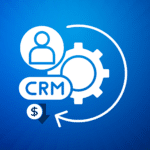
The Ultimate Guide to Overcoming CRM Integration Challenges
Customer Relationship Management (CRM) tools are essential for businesses today. They help keep track of customer interactions, manage sales pipelines, and improve customer service. By bringing customer data into one central location, CRMs allow companies to make better decisions and provide improved services. However, integrating CRM systems with other business tools, such as ERPs, marketing platforms, or inventory systems, can be difficult. The integration process can feel complicated, time-consuming, and even frustrating for many businesses.
In this article, we will explore the common CRM integration challenges businesses face and offer practical solutions to overcome these obstacles.
CRM Integration Challenges
Some of the most prevalent CRM integration challenges in business include:
Data Incompatibility
The first and foremost point of concern with CRM integrations is data incompatibility. Data is stored and presented in different ways depending on the system. When being integrated with a few other third-party tools, such as a CRM, ERP or marketing platform, mismatched data formats can lead to wrong data imports or even data loss. This can make it hard to ensure customer information is synced among systems.
Complexity of Integration
Integrating a CRM with other tools such as ERPs, marketing platforms, or financial systems can be complicated. Every system is different, and connecting them usually requires custom coding, data field mapping or middleware solutions. The more systems you’re trying to connect, the more challenging it is to keep it all synchronized.
Cost Overruns
Workflows with CRM can become pretty costly. A lot of businesses fail to realize how costly it can be, predominantly when tailored integrations are required. Costs can be acquiring integration software, outsourcing to external consultants, or allocating internal resources to the implementation. Without proper planning, these costs can easily spiral.
Customization Issues
Customizing your CRM to suit your business’s precise needs is standard practice, but it makes it tricky to integrate. Some custom features may not work with other systems you have which you want to connect to, which can make it difficult to ensure that data syncs between them. This may mean that businesses need to bring some nuance or even redo their customization to streamline everything.
Lack of Skilled Resources
The integration with your CRM, which should in fact be something your own company has technical expertise in, is a common pitfall for businesses that don’t have these specific skills in-house. In absence of the correct tools the process might take longer and can be subject to mistakes or inefficacies. And if you can’t do it internally, then partnering with the right expert for your company is usually the right way to go.
Steps to Overcome CRM Integration Challenges
Now that we’ve discussed the common CRM integration challenges, let’s look at how you can tackle them and ensure a smooth integration process.
Choose the Right Integration Tools
Selecting the right integration tools is key to overcoming data compatibility issues. Look for tools or middleware that support both your CRM and the other platforms you’re trying to integrate. These tools should be flexible enough to handle different systems and data formats, reducing the likelihood of issues down the line.
Clean and Standardize Your Data
Before starting the integration, take time to clean and standardize your data. Inconsistent or outdated data can cause errors when syncing it across systems. Make sure all the data is accurate and up-to-date before the integration begins. Regularly auditing your data helps ensure it remains consistent as your business grows.
Use Automation and Pre-built Connectors
The process of integration can be greatly simplified through automation. There are many platforms available who have pre-built connectors that can seamlessly sync data between systems without requiring complex coding. They can save you time and simplify the complexity of the integration process, allowing your business to progress faster and smoother.
Test and Optimize
Before going live with your new integrated CRM system, it’s important to test it thoroughly. Look for any data errors, system failures, or performance issues. Once the integration is live, continue to monitor it and make adjustments as needed. Ongoing optimization helps ensure that your system continues to meet your needs and runs as smoothly as possible.
Best Practices for Seamless CRM Integrations
Let’s now discuss some best practices that will help you achieve smooth and seamless CRM integrations:
Start Small and Scale Up Gradually
Instead of trying to integrate everything at once, start with just a few key integrations. This allows you to test the waters and address any issues before expanding to more complex systems.
Involve All Relevant Teams
It is also critical to bring onboard people who will actively use the CRM right from the start. For example, this must include members of the sales team, marketing team, and customer support staff. Their feedback will guarantee that all the departments are catered for in the integration process.
Set Clear Goals
Decide what specific problems you wish to solve with the CRM. Is it improving data accuracy, automating workflows, or reducing manual data entry? Clear targets will always lead to more efficient integration results.
Conclusion
In conclusion, overcoming CRM integration challenges is crucial for businesses seeking to improve their operations and ensure a smooth flow of data across systems. By addressing common issues businesses can achieve seamless CRM integrations that enhance productivity and customer satisfaction.
If you’re looking for professional guidance to streamline your CRM integrations, partnering with an expert like Manras, a Salesforce-certified consultant, can make all the difference. Manras’s expertise in CRM systems ensures that your integrations are not only efficient but also tailored to your specific business needs.
For more insights, updates, and expert tips, follow us on LinkedIn.



